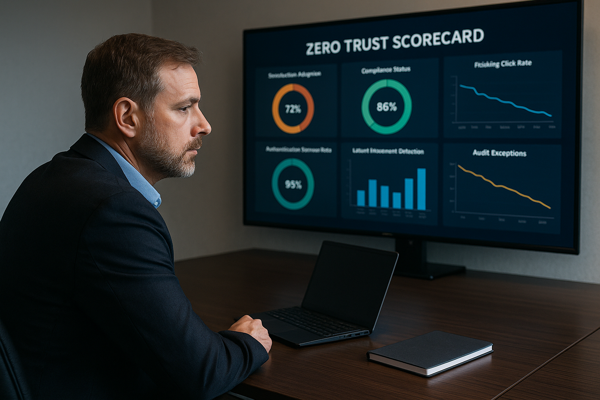Imagine the boardroom silence when the CISO begins: “Generative AI isn’t a futuristic luxury—it’s here, reshaping how we operate today.” The questions start: What is our AI exposure? Where are the risks? Can our policies keep pace? Today’s CISO must turn generative AI from something magical and theoretical into a grounded, business-relevant reality. That urgency is real—and tangible. The board needs clarity on AI’s ecosystem, real-world use cases, measurable opportunities, and framed risks. This briefing kit gives you the structure and language to lead that conversation.
Problem: Board Awareness + Risk Accountability
Most boards today are curious but dangerously uninformed about AI. Their mental models of the technology lag far behind reality. Much like the Internet or the printing press, AI is already driving shifts across operations, cybersecurity, and competitive strategy. Yet many leaders still dismiss it as a “staff automation tool” rather than a transformational force.
Without a structured briefing, boards may treat AI as an IT issue, not a C-suite strategic shift with existential implications. They underestimate the speed of change, the impact of bias or hallucination, and the reputational, legal, or competitive dangers of unmanaged deployment. The CISO must reframe AI as both a business opportunity and a pervasive risk domain—requiring board-level accountability. That means shifting the picture from vague hype to clear governance frameworks, measurable policy, and repeatable audit and reporting disciplines.
Boards deserve clarity about benefits like automation in logistics, risk analysis, finance, and security—which promise efficiency, velocity, and competitive advantage. But they also need visibility into AI-specific hazards like data leakage, bias, model misuse, and QA drift. This kit shows CISOs how to bring structure, vocabulary, and accountability into the conversation.
Framework: Governance Components
1. Risk & Opportunity Matrix
Frame generative AI in a two-axis matrix: Business Value vs Risk Exposure.
Opportunities:
-
Process optimization & automation: AI streamlines repetitive tasks in logistics, finance, risk modeling, scheduling, or security monitoring.
-
Augmented intelligence: Enhancing human expertise—e.g. helping analysts faster triage security events or fraud indicators.
-
Competitive differentiation: Early adopters gain speed, insight, and efficiency that laggards cannot match.
Risks:
-
Data leakage & privacy: Exposing sensitive information through prompts or model inference.
-
Model bias & fairness issues: Misrepresentation or skewed outcomes due to historical bias.
-
Model drift, hallucination & QA gaps: Over- or under-tuned models giving unreliable outputs.
-
Misuse or model sprawl: Unsupervised use of public LLMs leading to inconsistent behaviour.
Balanced, slow-trust adoption helps tip the risk-value calculus in your favor.
2. Policy Templates
Provide modular templates that frame AI like a “human agent in training,” not just software. Key policy areas:
-
Prompt Use & Approval: Define who can prompt models, in what contexts, and what approval workflow is needed.
-
Data Governance & Retention: Rules around what data is ingested or output by models.
-
Vendor & Model Evaluation: Due diligence criteria for third-party AI vendors.
-
Guardrails & Safety Boundaries: Use-case tiers (low-risk to high-risk) with corresponding controls.
-
Retraining & Feedback Loops: Establish schedule and criteria for retraining or tuning.
These templates ground policy in trusted business routines—reviews, approvals, credentialing, audits.
3. Training & Audit Plans
Reframe training as culture and competence building:
-
AI Literacy Module: Explain how generative AI works, its strengths/limitations, typical failure modes.
-
Role-based Training: Tailored for analysts, risk teams, legal, HR.
-
Governance Committee Workshops: Periodic sessions for ethics committee, legal, compliance, and senior leaders.
Audit cadence:
-
Ongoing Monitoring: Spot-checks, drift testing, bias metrics.
-
Trigger-based Audits: Post-upgrade, vendor shift, or use-case change.
-
Annual Governance Review: Executive audit of policy adherence, incidents, training, and model performance.
Audit AI like human-based systems—check habits, ensure compliance, adjust for drift.
4. Monitoring & Reporting Metrics
Technical Metrics:
-
Model performance: Accuracy, precision, recall, F1 score.
-
Bias & fairness: Disparate impact ratio, fairness score.
-
Interpretability: Explainability score, audit trail completeness.
-
Security & privacy: Privacy incidents, unauthorized access events, time to resolution.
Governance Metrics:
-
Audit frequency: % of AI deployments audited.
-
Policy compliance: % of use-cases under approved policy.
-
Training participation: % of staff trained, role-based completion rates.
Strategic Metrics:
-
Usage adoption: Active users or teams using AI.
-
Business impact: Time saved, cost reduction, productivity gains.
-
Compliance incidents: Escalations, regulatory findings.
-
Risk exposure change: High-risk projects remediated.
Boards need 5–7 KPIs on dashboards that give visibility without overload.
Implementation: Briefing Plan
Slide Deck Flow
-
Title & Hook: “AI Isn’t Coming. It’s Here.”
-
Risk-Opportunity Matrix: Visual quadrant.
-
Use-Cases & Value: Case studies.
-
Top Risks & Incidents: Real-world examples.
-
Governance Framework: Your structure.
-
Policy Templates: Categories and value.
-
Training & Audit Plan: Timeline & roles.
-
Monitoring Dashboard: Your KPIs.
-
Next Steps: Approvals, pilot runway, ethics charter.
Talking Points & Backup Slides
-
Bullet prompts: QA audits, detection sample, remediation flow.
-
Backup slides: Model metrics, template excerpts, walkthroughs.
Q&A and Scenario Planning
Prep for board Qs:
-
Verifying output accuracy.
-
Legal exposure.
-
Misuse response plan.
Scenario A: Prompt exposes data. Show containment, audit, retraining.
Scenario B: Drift causes bad analytics. Show detection, rollback, adjustment.
When your board walks out, they won’t be AI experts. But they’ll be AI literate. And they’ll know your organization is moving forward with eyes wide open.
More Info and Assistance
At MicroSolved, we have been helping educate boards and leadership on cutting-edge technology issues for over 25 years. Put our expertise to work for you by simply reaching out to launch a discussion on AI, business use cases, information security issues, or other related topics. You can reach us at +1.614.351.1237 or info@microsolved.com.
We look forward to hearing from you!
* AI tools were used as a research assistant for this content, but human moderation and writing are also included. The included images are AI-generated.




